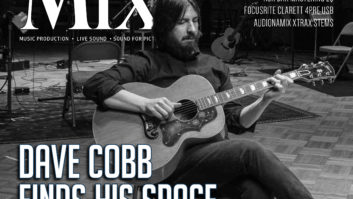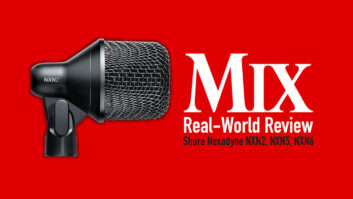The Manley Nu Mu is a 2-channel, variable-mu limiter/compressor designed to operate as either a stereo processor or two individual channels. It has a wide processing range, anywhere from extremely transparent for just “touching” a stereo mix, to serving more as “glue” when driven harder.
Like the original Variable Mu, the Nu Mu starts with Manley’s IRON input transformers and four 6BA6 pentodes in the company’s TBAR Mod configuration where the first-stage pentode is wired as a triode. But then the Nu Mu departs from the Variable Mu’s circuit by using a discrete high-voltage transistor and FET (field effect transistor) circuit for its transformerless output. There are no operational amplifiers used, and the sidechain technology from the all-tube Variable Mu appears in a solid-state version.
Also new is an ultra-low-impedance, switched-mode power supply that provides 145-volt plate high voltage, 6.3-volt filament voltage, and the ±15 VDC for the transistor circuitry. Both the audio transformers and power supply are also used in the Manley CORE Reference Channel strip and the Force 4-Channel Microphone preamp.

Controls
The Nu Mu has lighted pushbutton switches made by EAO, NKK toggle switches, sealed Lorlin rotary switches, and Bourns pots. I like these lit pushbuttons for easy verification in dark control rooms.
The Nu Mu uses a three-position Input level toggle switch for each channel rather than the single ganged pot for both channels as in the Variable Mu, which made setting up dual-mono operation tricky. The toggle switches, the only ones on the unit, have -3 dB, 0 dB and +3 dB input operating level choices. Maximum input levels are: +25 dBu, +21 dBu and +18 dBU, respectively.
I liked that the input level is fixed and calibrated, which I find especially important when setting up the Nu Mu as a stereo mix bus processor. The Nu Mu has a pair of large, blue backlit Nissei VU meters that oppose each other. A lighted pushbutton toggles them to read either gain reduction or output level; it’s easier to match L/R settings with the meters configured like this. Love it!
When setting up the Nu Mu with reference tones in my mix room, each channel’s controls matched each other, the unit’s VU meter and my external measurements within 0.25 dB. This is not easy to do with tube-based audio electronics. It is indicative of a careful design, tight component tolerances, precision manufacturing, and tube testing and matching.
Separate controls for each channel mimic the original Variable Mu, with each channel having continuously variable Output, Threshold and Attack controls. Attack times range from fully CCW for the slowest at 0.13 seconds, midway at 0.07, and fully CW for the fastest release at 0.013 seconds.
The Recovery (release) time control uses five rotary switch positions: 0.1, 0.16, 0.32, 0.64, and 1.7 seconds. Front-panel controls continue with a Compress/Limit switch for either 3:1 or 10:1 compression ratios, and a channel Link switch that links the left channel’s threshold, attack and recovery settings to the right channel. Nu Mu has a master hardware (relay) Bypass switch, and I liked that all controls and metering remain adjustable and active during bypass.
An HP SC on/off switch engages a 6 dB/octave, 100 Hz highpass sidechain filter, which I found essential for stereo mix program processing on the modern, bass-heavy pop music I mix.
Related: Manley Labs Introduces the Nu Mu, Jan. 21, 2016
The new HIP function acts like a secondary threshold level setting so as to compress more and raise the level of lower-level signals, yet retain the desired amount of gain reduction on the louder sections without excessive squashing.
The rear panel has an IEC socket for worldwide voltages of 90 to 250 VAC; however, the line fuse is located inside the cabinet right on the switched-mode power supply module. Each channel has its own input and output XLRs, plus Send/Return TRS external sidechain insert jacks. These jacks are placed in circuit before the unit’s HP SC filter.

On the Stereo Bus
Nu Mu has a lighted power switch when it is plugged in; when switched on, the unit goes through a 30-second warm-up period where the VU meters flash and the outputs mute. Once warmed up, the unit comes up in the same state as when last powered off.
I started evaluations with the Nu Mu on the stereo insert of my analog SSL Sigma Summing Engine. For a country song that was to be mastered, I was interested in increasing the overall density of the mix while not clipping the peaks and still maintaining some headroom. I wanted the mastering engineer to work with a pristine-sounding mix.
My Pro Tools rig uses -18 dBFS = 0dB reference; I use a 1 kHz calibration tone for all 64 multitrack I/O channels and have a Benchmark Media ADC1 A/D converter connected to the stereo bus output of the Sigma.
With the Nu Mu inserted with threshold at maximum (no gain reduction), levels matched coming from a single stem output of Pro Tools to a stereo channel in the SSL Sigma, with its stereo bus at unity and routed back into the Benchmark to be recorded to a new stereo track in Pro Tools. This is the same method I would connect the Nu Mu for use with an analog mixing console.
Related: Piper Payne Masters All with Manley, Sep. 26, 2016
In Compress mode, I used the Nu Mu’s 0 dB Input level position and made up 4 dB of gain for 1 to 3dB of max compression as indicated on the unit’s VU meters. The track became noticeably louder and denser, with ambience and mix details clarified.
I used the HP SC, but I wish it had two more frequency choices besides 100 Hz—maybe 50 Hz and 200 Hz. Attack time was medium-slow and recovery was at 0.64 seconds with the stereo link on. I used the HIP function and heard more compression on the quieter verses. With HIP off, every soft snare hit did not necessarily compress, and with it on, I got more consistent compression operation on low-level moments; the big and loud dynamic moments sounded the same as they do with HIP off.
Next, I tried the Nu Mu for mastering a stereo mix file. I had an aggressive EDM song where I was looking for color, control and relentless level! I used the compress mode, slowest attack and fastest recovery times, and the HP SC. HIP worked wonders to bring forward a transparent stereo pad in the mix in just the right way. To allow for the super-wide stereo effects of this club mix, I unlinked channels and got the level up to around -12 LUFS as measured on Nugen Sound Check Pro, all without clipping in Pro Tools.
Related: For Colin Hay, Manley Products Are Never “Overkill,” July 25, 2016
Instrument and Vocal Tracks
On Fender bass I could use either compress or limit mode—a la an LA-2A. I didn’t use the HP SC or HIP, and I got a steady and leveled bass sound, much like other tube compressors but cleaner and clearer. I like using the Input switch for quickly pushing more level into Nu Mu for more compression and color without changing any other controls. I started at my calibrated 0 dB position with 1 to 3 dB of gain reduction, then instantly could go more conservative by switching to the -3 dB position—or not! Jump up to +3 dB for driving compression more aggressively.
Using a tube limiter for processing a snare drum track was a surprise for me. In Limit mode, with HP SC in play and fastest recovery times, I adjusted the attack time depending on how much of the “front” or stick attack was needed in the track. I used each channel of the Nu Mu; one channel for the snare-top mic track and the other channel for the bottom mic’s track. I did not link the channels and the HIP switch gave me a choice between a more natural snare drum sound (HIP switch in) and a radically tighter “thwack” with it switched out.
Nu Mu works great as a vocal compressor much like the original Variable Mu, but during the “heat of the session,” I seem to arrive at a good setting faster with the Nu Mu. Plus, the exact settings are not as critical as other compressors when recording. Nu Mu is a good choice for tracking if isn’t already busy doing something else in your studio.
Nu Mu is not your father’s Variable Mu but carries on the tradition of the original unit with modern additions and a totally distinct sound of its own. It is versatile and great for any source. I use it every day on the stereo mix bus; it adds a finished polish with an average level and density increase, without adding distortion or reducing transparency.
Highly recommended!
Product Summary
Company: Manley Labs
Product: Manley Nu Mu Stereo Limiter/Compressor
Website: www.manley.com/pro/mnumu
Price: $2,800 MSRP
Pros: Precision-designed, modern-sounding
Cons: Could use more Recovery time choices







